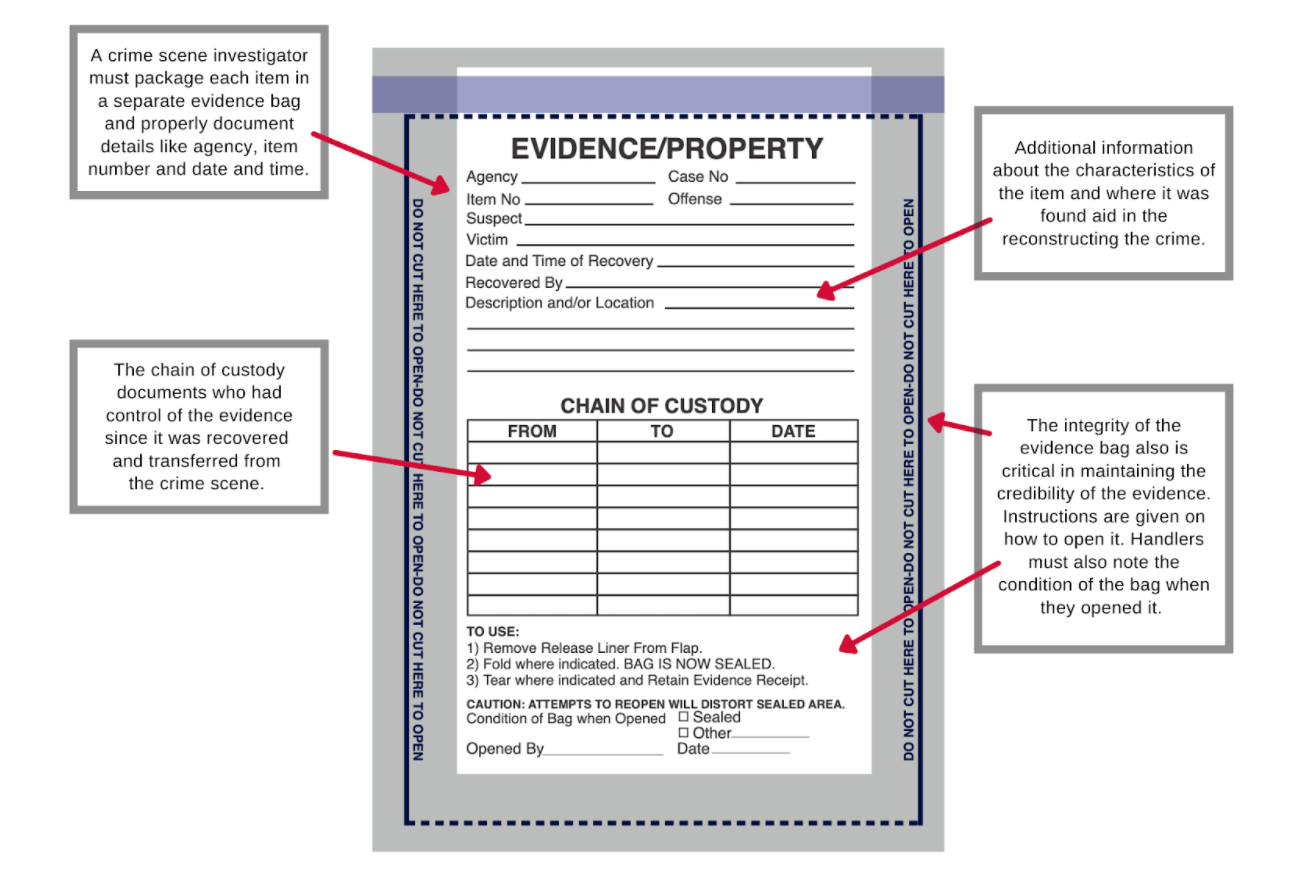From finding and collecting it to bagging it, gathering physical evidence for a criminal investigation has many facets.
“Inadmissible.” That’s the last thing any prosecutor wants to hear from a judge as part of a criminal investigation case.
That’s why the collection of hard evidence—and not just a series of “he said, she said” eyewitness testimonies—is so critical to the successful prosecution of a case. When collecting physical evidence, experienced crime scene investigators will painstakingly go through a series of steps to ensure that they’re objectively contributing to a case that leaves little doubt about who committed the crime.
While every criminal act is highly unique, there are generally 5 steps a crime scene investigator takes when collecting evidence:
- Recognizing physical evidence at the scene
- Collecting the evidence
- Documentation of evidence
- Secure packaging and preservation of evidence
- Ensuring the integrity of the chain of custody (who has the evidence and when)
Looking for signs of physical evidence at the scene
What’s evidence? The list of what can be presented as physical or biological evidence in a criminal case can be extensive. Here are 16 of the types of evidence that a crime scene investigator may examine, document and collect:
- Blood
- Saliva
- Fingerprints
- Skin cells
- Footprints
- Hair
- Clothing fibers
- Fire debris
- Gunshot residue
- Weapons (knives, firearms, blunt objects, etc.)
- Bullets
- Glass
- Fractured objects
- Drugs and paraphernalia
- Computers and devices
- Tire tracks
Collecting physical evidence to avoid contamination
During an investigation of a crime scene, there is a high risk of evidence being disturbed, and, as a result, contaminated, whether it’s footprints, DNA, gunshot residue or clothing fibers. To ensure integrity of the space, crime scene investigators will typically undergo the following process:
- Secure the area: Investigators analyze the crime scene and secure the areas most likely to contain evidence.
- Collect the evidence—changing gloves and tools frequently: To make sure the evidence isn’t cross-contaminated with their own DNA or debris, the crime scene investigators will wear gloves to collect each piece of evidence or sample. It is important to constantly change gloves throughout the process.
For instance, if a crime scene investigator swabs a surface for DNA, they must change gloves before moving on to collect the next sample. If they take notes, they must take off the current set of gloves before touching the pen, clipboard or evidence bag. Not only is it possible for the person gathering the evidence to contaminate, they also run the risk of exposing themselves to dangerous chemicals without the proper coverings, such as gloves.
For the same reason that it’s important to use gloves as part of the evidence-gathering process, crime scene investigators also will use disposable tools to pick up items — throwing them out after each use. It’s also possible that they have non-disposable tools that are later cleaned and thoroughly disinfected before the next use.
- Minimize contact with any surfaces that may contain evidence. This includes touching items, including walls and door knobs, or talking, sneezing and coughing within the secured space.
- Carefully place evidence in the proper bags or envelopes for documentation and the transfer process (i.e., to a forensic scientist who may analyze the evidence in a laboratory).
Documentation of evidence
Throughout an investigation, a crime scene investigator will be looking for both the obvious and obscure as soon as they arrive on the scene. As part of that meticulous process, they will document every possible clue of what happened during the crime, including the following:
- Taking comprehensive notes in chronological order about what they’re observing (from open windows and torn curtains to blood spatter and broken glass)
- Photographing the crime scene from different angles and proximities, using digital cameras that can allow them to immediately upload images into a computer system.
- Sketching out the crime scene, capturing dimensions and other measurements
- Videotaping various aspects of the crime scene
- Casting of footprints or tire impressions
- Developing and lifting fingerprints
- Filling out details correctly on evidence bags, including the all-important chain of custody about who handled it and when. If the proper chain of custody is broken or if the evidence is not handled properly, the evidence can be thrown out as inadmissible in a case. The details will include:
- Name of agency (i.e. police department, FBI, etc.)
- Case number
- Item number (of evidence)
- Victim’s name, if known
- Suspect’s name, if known
- Type of crime
- Time and date evidence was collected
- Who it was recovered by
- Details about the location and condition of the evidence
- Chain of custody (i.e. who collected the evidence, who transferred the evidence, who received and analyzed the evidence, etc.) and date of custody

Packaging and preserving the evidence
The process of properly packaging and preserving the evidence also is critical in ensuring the integrity and validity of each physical or biological item. This is especially important when handling and storing evidence that may contain DNA that must be sent to a forensic scientist for analysis.
Here are some of the steps for the proper handling, storage and transfer of evidence collected from a crime scene:
- Keep DNA evidence dry and at room temperature
- Carefully secure it in paper bags or envelopes (making sure not to cross-contaminate with uncovered hands, previously used gloves or previously used tools)
- Do not use plastic bags for DNA samples because they can promote moisture that can damage the DNA sample. Also, direct sunlight and heat can disturb the integrity of DNA.
- Make sure the evidence is sealed, documented, and transported so that the appropriate chain of custody is always followed.
- Make sure the vehicle used to transport the evidence has air conditioning to keep it at the proper temperature
- Make sure the evidence is properly stored in a building until it is analyzed by a forensic scientist or when it is retrieved for a court case.
Detailed from start to completion
For the crime scene investigator, perfection must be the goal from the first moment they arrive at a crime scene. With so much on the line in tying clues from the crime scene to recreate what happened and by who, it is critical that the crime scene investigator carefully follows proper procedures in the collection and documentation of evidence.

